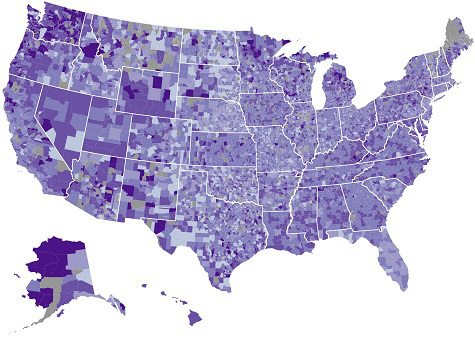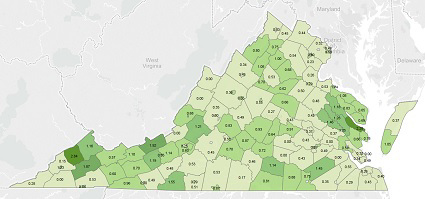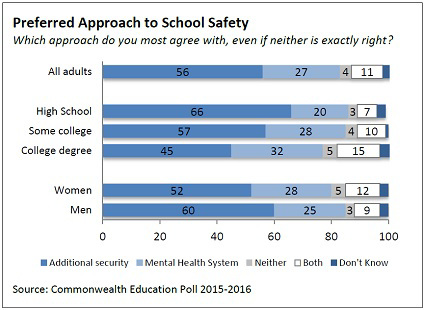 |
| State & Local Education News |
This house — built with the help of high school students — is on the market for $935,000
Washington Post
June 12, 2016
This home has all the amenities you’d expect of a suburban Washington residence, including an airy master bedroom, walk-in closets and a spacious kitchen with a broad island. It sits on a cul-de-sac in Springfield, Va., and is on the market for $935,000.
What might not be apparent is that the home — a five-bedroom, four-bath house sitting on a third of an acre — is a grand class project, built with the help of Fairfax County high school students who worked alongside professionals as part of a building trades class.
It is a classroom as well as a home, where students learned how to cut and install crown moulding, to frame homes, and to install tile and appliances. It provides valuable experience for those interested in becoming construction workers and gives a practical edge to students who want to become architects or engineers.
UVA Responds Department of Education Rape Report
NBC 29 (WVIR)
June 8, 2016
The University of Virginia is responding to a Department of Education report saying the university ranks fifth in reported rapes.
Nearly 100 colleges and universities had at least 10 reports of rape on their main campuses in 2014. UVA had 35 reported rapes.
Brown University topped the list with 43.
A university spokesperson says, "The university continues to implement substantive initiatives aimed at enhancing the safety and well being of every member of its community, including concerted efforts to increase reporting and awareness of sexual violence and all forms of sexual harassment."
[Opinion] Koch: Cost increases at Virginia public colleges
Richmond Times Dispatch
June 6, 2016
The give and take between members of the General Assembly and the College of William & Mary over the school’s tuition increase once again has pushed the issue of higher education costs to the fore in Virginia. The stakes are large. In 2006, 412,336 students attended the commonwealth’s public colleges. By 2015, that number had climbed to 534,280, a 30 percent increase.
Higher education is big business. In 2015, 56,777 individuals were on public college payrolls in Virginia, and the doctoral institutions’ budgets for 2016-2017 ranged from William & Mary’s approximately $450 million to the more than $1.4 billion of the University of Virginia.
But for what purpose? Are the institutions being operated with the best interests of the citizens of the commonwealth in mind, or instead to satisfy the interests of faculty and administrators at the institutions?
Montgomery County girls learn the sky's the limit
Roanoke Times
June 11, 2016
Taylor Givens was seeing the world a little differently than normal on Saturday morning.
“The cars looked like my brother’s little toy cars. It was so funny,” the Auburn High School 10th grader said.
Taylor was one of 100 girls from Montgomery County Public Schools who had the opportunity to fly more than 3,000 feet above Roanoke as a part of the Virginia Department of Aviation’s Women Can Fly program at the Roanoke-Blacksburg Regional Airport.
“We got to see the star of Roanoke ... it looked like a little grain of rice,” she said.
Launched in 2013, the program is co-sponsored by The Ninety-Nines, an international organization of women pilots, and is focused on not only changing female students’ view for the day, but also their perspectives of flight-related careers.
|
National & Federal Education News
|
Disparities Continue to Plague U.S. Schools, Federal Data Show
Ed Week
June 7, 2016
New federal data show a continuing deep gulf between the educational experiences of traditionally disadvantaged student groups and their peers on a broad range of indicators, findings that follow years of efforts by government and advocacy groups to level the playing field in U.S. public schools.
Black and Latino students are still more likely to be suspended, more likely to attend schools with high concentrations of inexperienced teachers, and less likely to have access to rigorous and advanced coursework than their white peers, according to the data released today by the U.S. Department of Education’s office for civil rights.
“Our systemic failure to educate some groups of children as well as others tears at the moral fabric of the nation,” U.S. Secretary of Education John B. King Jr. said in a call with reporters. The data, which highlights disparities for students of color, students with disabilities, and English-language learners, shows that “we still fall far short” of the ideal of educational equity, he said.
New Research Report: Are U.S. Schools Inefficient?
Shanker Institute
June 7, 2016
Putting aside the actual relative efficiency of U.S. schools, these particular statements about U.S. education spending and performance are so rife with oversimplification that they fail to provide much if any useful insight into U.S. educational efficiency or policy that affects it. Our
new report, written by Rutgers University Professor Bruce D. Baker and Rutgers Ph.D. student Mark Weber, explains why and how this is the case. Baker and Weber’s approach is first to discuss why the typical presentations of spending and outcome data, particularly those comparing nations, are wholly unsuitable for the purpose of evaluating U.S. educational efficiency vis-à-vis that of other nations. They then go on to present a more refined analysis of the data by adjusting for student characteristics, inputs such as class size, and other factors. Their conclusions will most likely be unsatisfying for all “sides” of the education debate.
The Evolution of the 'Chartered School'
Ed Week
June 3, 2016
Twenty-five years ago this month, tucked in a voluminous education funding bill headed to the Minnesota governor’s desk, was a quirky and contentious idea to allow teachers and parents to create a new kind of public school—chartered schools.
With a stroke of his pen, then-Gov. Arne Carlson signed into existence a movement that has grown over the last quarter-century into a national juggernaut: a charter school sector with thousands of schools, millions of students, a cadre of deep-pocketed benefactors, dozens of advocacy groups, and sophisticated networks of schools that in some cases dwarf the nation’s average-size school district.
Although charter school students only make up about 5 percent of the 50 million K-12 public school students in the country, charters have posed the only credible competition to the traditional system of public schooling. While the growth of charters has mostly been in large urban districts, in 14 of those cities, such as San Antonio, Detroit, and Philadelphia, charters now enroll at least 30 percent of children in public schools.
More Than 6 Million U.S. Students Are 'Chronically Absent'
NPR
June 10, 2016
It's one of the oldest issues in school improvement: Getting kids to show up. If students miss 10 percent of the school year — that's just two days a month —research shows they are way more likely to fall behind — even drop out.
Today, the U.S. Education Department is releasing a report on the first national data set on chronic absence — defined as missing 15 or more days of school a year.
The numbers come from the 2013-2014 Civil Rights Data Collection survey — an on-the-ground look from 95,000 schools.
The numbers are striking: More than 6 million kids are missing 15 days or more of school a year.
Chronic absenteeism rates are highest in high school: more than 2 million high schoolers are missing 15 days or more.
The figures for minority students are even more alarming: More than a fifth of black high schoolers are chronically absent. It's 20 percent for Latino high school students and 27 percent for American Indians and Native Alaskans.
|
|
|
How big an issue is chronic absenteeism?
This past week the U.S. Department of Education released a
new report on the prevalence of chronic absenteeism in schools across the country. Based on data from the 2013-14 Civil Rights Data Collection, the report's main headline was that 6 million children in the U.S. (about 13%) were chronically absent from school, meaning they missed more than 3 weeks of school across the school year. The levels of absenteeism was greatest in high school.
The report summarizes the importance of mitigating absenteeism by noting:
Chronic absenteeism is widespread—one out of every eight students missed three weeks or more of school in 2013-14. That translates to 93 million school days lost. Research suggests the reasons for chronic absenteeism are as varied as the challenges our students and families face—including poor health, limited transportation, and a lack of safety—which can be particularly acute in disadvantaged communities and areas of poverty.
Whatever its causes, chronic absenteeism can be devastating:
-
Children who are chronically absent in preschool, kindergarten, and first grade are much less likely to read at grade level by the third grade.
-
Irregular attendance can be a better predictor of whether students will drop out before graduation than test scores. (Students who drop out are more likely to suffer diminished health and involvement in the criminal justice system
The report contains a data visualization for the rate of absenteeism for every school system in the U.S. (Click on the map or
here to go to the report itself - unfortunately the map is not interactive.)
 |
| Map developed by Dept. of Education - darkest is 30%+ |
|
| |
Also, for ease of reference, here's a zoomed in view of Virginia.
We hope to return to this CRDC data for some visualizations of our own in the future. In the meantime, we also wanted to share a couple insights with you that are unrelated to absenteeism.
Currently, the mass shooting early Sunday morning in Orlando is very much on all our minds. Our thoughts are with all those grieving the loss of loved ones, as well as those recovering from injuries, physical and otherwise. Many people are also likely re-evaluating the safety of otherwise familiar locations. In light of this, our
Poll Snapshot reviews the findings of our 2016 Education Poll on how safe the public feels that schools are, as well as what broad methods they support for improving security. As our summary notes, despite a number of school based mass shootings over the years, a majority of the public still feels that schools in their community are safe or very safe. Likewise, a majority of adults feel that "additional security" is the approach to school safety that they most agree with, compared to greater investment in the mental health system. On a related note, readers may also find a visualization of school systems' 2006 use of School Resource Officers (SROs) that we did back in the fall of 2015 to be of interest. (2006 was the last year for which data is available.) Click on the graphic below or
here to reach the Tableau workbook.
 |
| SROs per 1000 students |
This week we wanted to again
review the range of topics covered in this year's issues of the Education Law Newsletter, edited (and often written by) Dr. Richard Vacca. As the school year draws to a close, we want to thank Dr. Vacca and the other authors who contributed to the newsletter this year for their great work and insights.
As school years draw to a close, we wish each of you well. Keep an eye on your inbox throughout the summer as Compass Point will continue its weekly publication schedule.
Sincerely,
CEPI
|
CEPI Poll Snapshot - Does the public feel schools in their community are safe?
A short data insight from our
Commonwealth Education Poll.
Majority See Schools as Safe or Very Safe
Despite several high profile mass shootings in the past few months, a majority of Virginians feel the schools in their community are safe. Seventy-nine percent (79%) of respondents indicated feeling their community’s schools were safe or very safe, with 25% saying they were very safe. Only 19% felt their schools were not very or not at all safe.
There were regional differences for those who felt their schools were safe or very safe. Respondents from Northern Virginia (30%), the West region (31%) were more likely to say their schools were very safe. In contrast, respondents from Tidewater (28%) were more likely to say schools were not very safe or not at all safe. (To get a sense of which areas make up these regions, please see the map below.)
Family income and age also played a role in the safety perceptions of respondents. Those with annual household income above $100,000 (37%) were more likely to say their schools are very safe, compared to 23% for those earning $50,000 to $100,000 and 20% for those earning less than $50,000. Likewise, those aged 35-44 (35%) were more likely to say their schools are very safe, compared to 18-34 year olds (21%), 45-64 year olds (25%) and those 65 or older (26%).
Majority prefer to address school safety issue through added security measures
Respondents were also asked their opinion on approaches to addressing issues of school safety, specifically whether to use additional security measures or the mental health system. A majority (56%) agreed that additional security measures should be used to address school safety. About a quarter of respondents, 27%, thought that safety issues should be addressed through the mental health system. Eleven percent (11%) offered that both approaches should be used.
 |
|
Again, there were regional differences regarding which approach to use. Respondents from the Tidewater (68%) and West (61%) regions were significantly more likely to think additional security measures should be used. Those in the South Central (35%) and Northern Virginia (31%) were more likely to think that the mental health system should be used.
Family income, education level, party and gender also played a role. Respondents with a household income over $100,000 (at 47%) were less likely to agree that additional security measures should be used, compared to 61% of those with incomes between $50,000 and $100,000 and 60% of those with incomes less than $50,000. Those with a high school diploma or less (at 66%) were more likely to think additional security measures should be used, compared to those with a college degree or higher, where only 45% said the same. With regard to party identification, 63% of Republicans think additional security measures should be used compared to 57% of Independents and 50% of Democrats. Finally, men were more likely to agree with using security measures (60%) compared to women (52%).
(To read the full poll, visit our
website.)
|
|
CEPI Education Law Newsletters - 2015-16
This week, we provide a quick review and listing of Education Law Newsletters from the past school year.
Overview
CEPI’s Education Law Newsletter is usually published monthly from September to June. It is edited by Richard S. Vacca, Ed.D., senior fellow at the institute, who brings decades of teaching experience in educational law to explaining emerging issues and crucial legal topics in the education sector. Authors for each regular issue are drawn from among experts in the education law field. From 2002 to 2015, Dr. Vacca both wrote and edited each edition.
|
|
